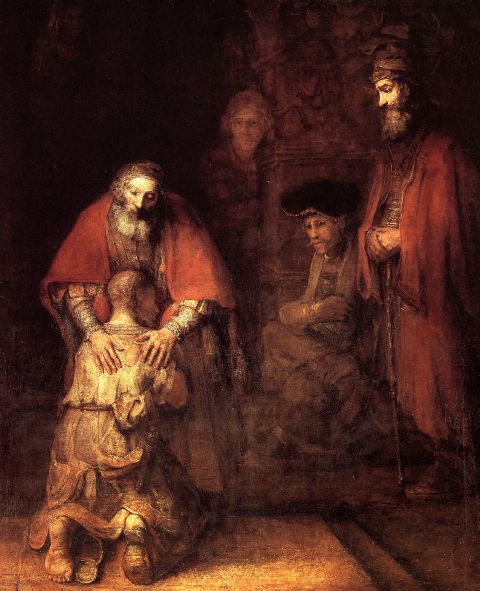Nouwen’s Return of the Prodigal Son
This is another book review I wrote on Henri Nouwen’s Return of the Prodigal Son, a spiritual jorney based on Rembrandt’s oil painting of the same time which itself is a pictoral representation of a parable told by Jesus in Luke.
This was a very nice book, was some very good insights to a spiritual walk with God. If you don’t read the review, at least read these two quotes that I think are a pretty good representation of what the book had to say.
“God rejoices. Not because the problems of the world have been solved, not because all human pain and suffering have come to an end, nor because thousnads of people have been converted and are now praising him for his goodness. No, God rejoices because one of his children who was lost has been found.”
And
“…once you choose to claim the joy hidden in the midst of all suffering, life becomes celebration. Joy never denies sadness, but transforms it to a fertile soil for more joy.”
Your should read the book. I also have included a picture of the Rembrandt at the end, it really is a gorgeous painting.
Matt Jones
December 6th, 2004
INDS 500: The Christian Life (Section B)
John Stackhouse
Word Count: 1471
Book Review #2
The Return of the Prodigal Son: A Story of Homecoming
Henri J.M. Nouwen
Nouwen, Henri J.M. The Return of the Prodigal Son: A Story of Homecoming.
Cambridge, New York: Doubleday, 1992.
This book is a reflection on Rembrandt�s oil painting, Return of the Prodigal Son. The painting is a representation of the parable Jesus told in Luke (15.11-32). The book is a journey that Nouwen takes as he moves through the three main characters in the painting and parable: the lost son, the older son, and the father. As is the case with the parable, Nouwen encourages a �homecoming� to our Eternal Father in God. The intent of this reflection is nicely stated in the thesis: ��I hope and pray that you too will discover within yourselves not only the lost children of God, but also the compassionate mother and father that is God� (23).
The book is laid out in three main sections along with an introduction, prologue and conclusion. The three main parts are reflections on the three main characters and how Nouwen has associated with them.
The prologue and introduction invite us on the spiritual journey that Nouwen has taken because of this painting. The framework of this reflection is that of Nouwen trying to discern where God would lead him in his career and the search for deeper understanding of the Rembrandt. After being able to study the original work at The Hermitage in St. Petersburg, Russia, as well as taking a position at �Daybreak� (a community for mentally handicapped people), Nouwen asserts that we have all filled the roles of the prodigal and elder son and should aspire to fill the role of the unconditionally loving father.
The first part of the book relates to the younger, �prodigal� son. This part is broken into three chapters. The first chapter shows how Rembrandt saw himself as the prodigal son: a proud man spending and wasting his money on lavish things that lost everything. The second chapter discusses the implications of the young son leaving the father. �Leaving home means ignoring the truth that God has �fashioned me in secret, molded me in the depths of the earth and knitted me together in my mother�s womb�� (37). Nouwen points out the often that voice calling us �Beloved� is often still and soft, especially compared to the louder voices of this world, but God�s love is not forced upon us. The third chapter discusses the return of the prodigal. Sometimes it takes us losing everything for us to see what we truly had. Nouwen points to Rembrandt leaving the short sword on the waist of the young son as a sign that he does not forget that he is his father�s son, the father he must return to. The path back is a difficult one especially when we still think the Father�s love is conditional. Nouwen then also suggests that Jesus is the ultimate prodigal son: He is rejected by those around Him after leaving the house of His loving Father who then returns to God on His knees at the Cross.
The second part reflects on the elder son who has stayed in his father�s house. This section, like the first, starts with a short chapter describing how Rembrandt was like the older son as well: bitter, eager for revenge, arrogant, and on. The second chapter of this section shows how the elder son, while not physically, has also left his father�s house. Often it is felt that, because one has stayed with the Father, blessings are more deserved. Resentment can be built up and doesn�t surface until tough situations and poor responses are made. Nouwen suggests that people become so worried about not sinning that repressed feelings can build up and take away from the freedom of the Father�s house. The third chapter of this section reflects on the return of the elder son. In some ways it is more difficult for the elder son to return as it can be difficult to move on from resentments held. Thankfully the father loves both sons equally and has called them both Beloved. Nouwen talks of the choice that must be made with respect to gratitude: one can either �choose to be grateful even when [one�s] emotions and feelings are still steeped in hurt and resentment� (85) or one can remain bitter. Both sons are therefore called to accept their father�s love and should cause a movement towards the likeness of the father.
The third part is the final focus: the father. Nouwen suggests that the father is who Christinas should strive to be like. The first chapter in this section, as with the first two sections, relates Rembrandt to the father. After many years of being the prodigal and the elder son, Rembrandt realized that the Father was who he should look to. The second chapter reflects on the welcome the father gives both sons. After having been alienated from their home, the sins of both sons are overlooked and they are both greeted by their father as Beloved. The Father has qualities of both the patriarch as well as the tender comforter of mother. Nouwen surmises that Christians are called to change their mindset to that of one who delights in God�s graciousness even if it appears that it has been more favorable to someone else (104). The third chapter of this section brings the reflection to a conclusion. The reality of the father�s love calls for a celebration. �God rejoices. Not because the problems of the world have been solved�. No, God rejoices because one of his children who was lost has been found� (114). The last reflection is that of moving forward: Christians are the returning son (the prodigal or the elder) and must claim that sonship and become the father (119).
The conclusion goes on to reiterate the idea that there is a need to come home to the Father and claim sonship by growing in Him; one cannot remain a child. Nouwen also recounts his spiritual journey by walking through the steps he took through the two sons on the way to the father.
Nouwen�s reflections are quite deep. They will cause a person to look at their heart and how they see the relationship between themselves and God. The one thing that could have strengthened his argument would be a shift of emphasis of the painting to the parable of Jesus. The book is a reflection of the painting, but that painting is a reflection of the parable. Nouwen, at times, makes it seem like the nuances that can be learned come from the painting and not the parable. His conclusions are all quite valid and can be arrived at regardless of which has more emphasis but would have had more root had they been in Jesus and not Rembrandt.
The way he laid out the book, focusing on the three main characters individually, helped his argument as each character has a sense of forward movement that can be applied to many different people at different times in their life. Because people can relate to one of the characters at different times, it is easy to find meaning in the other sections because it is likely that they will, at another time, relate to that character as well.
One thing that impressed me positively about this book is how close Nouwen was with the Rembrandt painting. This touched me very close as this painting has really affected me deeply. He was able to describe what my heart felt and that changed the way I looked at the painting as well as how I relate to the Father.
Another thing that impressed me positively about this book is how personal it was to Nouwen. The book wasn�t simply a discussion about some theological principle, it was about how the painting, the parable and the Father touched his life. This reflection moves Nouwen in a profound way and causes him to grow closer to God.
One thing that impressed me negatively about this book is Nouwen�s lack of connection between his reflections and how they led him to working with the Daybreak community. This book was such a personal reflection on Nouwen�s spiritual journey that also led him to that community and I wish he would have explored that connection more.
A second thing that impressed me negatively was his discussion of sorrow in our joy. I understand that with knowledge of the Truth we can take joy in everything, but just because we can, doesn�t mean that we do or know how. It would have been nice to hear more reflections on how, in the context of being one of the sons on the way to the father, should use joy to understand or help deal with sorrow. This would especially be helpful in being open and honest with the unbelieving around us. We are all on a journey and how to help each other on that journey would have made for good insight.




Recent Comments